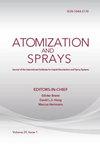A Study of Impinging Spray G on Transient Thermal Loading and Fuel1 Film Deposition
IF 0.9
4区 工程技术
Q4 ENGINEERING, CHEMICAL
引用次数: 0
Abstract
Under engine cold-start conditions, gasoline injections result in fuel deposition on the cylinder surfaces, due to inhibited fuel vapourisation when the contact surfaces are cold. This can lead to the presence of unburnt hydrocarbons and the formation of soot. The Engine Combustion Network’s (ECN) Spray G impinging on a wall, under various temperature conditions, was investigated using surface temperature measurements a suite of optical diagnostics including Low-Coherence Interferometry (LCI). PACE20 under different injection and ambient temperatures was tested. The measurements reported are of non-reacting conditions, whereby the focus of the study is to analyse spray-wall interaction, prior to flame arrival. The experiments were performed inside a spray vessel under engine-relevant conditions, with sprays impinging on a temperature-controlled wall equipped with nine fast-response, surface thermocouples. The wall was placed 40 mm downstream from the injector to represent the typical distance between the piston surface and injector during cold-start injections in the intake cycle. The injector was mounted on a rotational stage, causing different regions of the plume to impinge on the thermocouple array. This enabled high spatial and temporal resolution of the surface temperature measurements. LCI was used for film thickness quantification, which provided insights on the film dynamics upon impingement and the evaporation rates. High-speed visualisation techniques further aided in the understanding of transient fuel distribution on the wall.冲击喷雾 G 对瞬态热加载和燃料1 薄膜沉积的影响研究
在发动机冷启动条件下,汽油喷射会导致燃料沉积在气缸表面,原因是接触面冷时燃料蒸发受到抑制。这会导致未燃烧碳氢化合物的存在并形成烟尘。发动机燃烧网络 (ECN) 利用表面温度测量和低相干干涉仪 (LCI) 等一系列光学诊断技术,对各种温度条件下撞击壁面的 G 喷雾进行了研究。测试了不同喷射温度和环境温度下的 PACE20。所报告的测量结果是在非反应条件下进行的,因此研究重点是分析火焰到达之前喷壁之间的相互作用。实验是在发动机相关条件下的喷射容器内进行的,喷射物撞击在装有九个快速反应表面热电偶的温控壁上。温控壁位于喷油器下游 40 毫米处,代表进气循环冷启动喷油时活塞表面与喷油器之间的典型距离。喷射器安装在旋转台上,使不同区域的羽流撞击到热电偶阵列上。这使得表面温度测量具有很高的空间和时间分辨率。使用 LCI 对薄膜厚度进行量化,可深入了解薄膜在撞击时的动态和蒸发率。高速可视化技术进一步帮助了解燃料在壁上的瞬时分布。
本文章由计算机程序翻译,如有差异,请以英文原文为准。
求助全文
约1分钟内获得全文
求助全文
来源期刊

Atomization and Sprays
工程技术-材料科学:综合
CiteScore
2.10
自引率
16.70%
发文量
54
审稿时长
1.7 months
期刊介绍:
The application and utilization of sprays is not new, and in modern society, it is extensive enough that almost every industry and household uses some form of sprays. What is new is an increasing scientific interest in atomization - the need to understand the physical structure of liquids under conditions of higher shear rates and interaction with gaseous flow. This need is being met with the publication of Atomization and Sprays, an authoritative, international journal presenting high quality research, applications, and review papers.
 求助内容:
求助内容: 应助结果提醒方式:
应助结果提醒方式:


